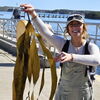
Maine markets arts and culture in bid to entice visitors to look beyond lobsters and lighthouses
When artist Thomas Cole, one of the founders of the Hudson River school of painting, traveled to Mount Desert Island in the 1840s to paint it, the area was a wilderness.
Cole's patrons from away, though, soon were traveling downeast to see it for themselves.
Think of it as Maine's first arts and culture tourism marketing.
Tourism in the state has steadily risen, from 25 million in 2016 to 26.2 million in 2017. While the top visitor attractions are related to food, shopping and sightseeing, according to the Maine Office of Tourism, there's an increasing effort to market arts and culture as part of the state's appeal.
“I think of Maine as a place where nature and culture meet,” says Suzette McAvoy, director and curator of the Center for Maine Contemporary Art in Rockland. The CMCA won the 2018 Governor's Award for Tourism Excellence last month, the state's top tourism award.
McAvoy says the center is a natural fit with Maine tourism.
“I think when tourists come to Maine, they want to experience a sense of place,” McAvoy says. “Its natural beauty has attracted artists for more than a century and it's resulted in this incredible legacy of art.” She says that aside from some national urban venues, “No state has impacted art more than Maine.”
Since its move, the CMCA has started marketing itself to the travel industry.
Chris Fogg, CEO of the Maine Tourism Association, says that marketing what the state has to offer to potential visitors is changing: “It's not just the usual tourist attractions, people are seeing there's more [to the state].”
'We have the story'

Hundreds of miles north, the aim is similar, though it's more of a struggle, says Sheila Jans, a cultural consultant in Madawaska.
Jans was part of a group that formed the international Voici the Valley International Cultureway in 2007, which promoted the cultural assets of the St. John River valley in both Aroostook County and New Brunswick. That effort led to development of the state's first cultural byway in 2014, the St. John Valley Cultural Byway.
While resources are hard to come by in Maine's largest and most northern county, Jans says the unique attraction of the rich mix of Acadian, French-Canadian, Scotch-Irish and native heritage, its 14 museums and dozens of historic sites, as well as its unspoiled natural beauty, are what many visitors are looking for.
One example is the Musee Culturel du Mont-Carmel in Lille, a former basilica, which houses the largest collection of Acadian and French-Canadian artifacts in the U.S., one of the crown jewels on the St. John Cultural byway.
Jans said that because the region doesn't have a strong entity to promote it widely, marketing often comes from outside organizations.
The Madawaska area co-hosted the World Acadian Conference in 2014, attended by more than 10,000 people, spread through northern Maine, Quebec and New Brunswick.
Leveraging the cultural assets of the region is key to sustainable tourism. “We don't have the resources, but we have the story,” Jans says.
“It's a combination of culture and place that is really authentic,” she says. “This isn't about a revival, it's about our culture.”
Traveling to a new place
The area will get another boost in September, when the annual 10-day BikeMaine trek runs from Presque Isle to St. Agatha. The event, which this year will have 450 bicyclists, has had a $2.3 million impact on the state since it began in 2012, the Bicycle Coalition of Maine says.
BikeMaine won the Originality Award this year from the Maine Office of Tourism.
The event is a complement to Maine's cultural offerings, says Frank Gallagher, communications director for the coalition.
“It's a tour, it's a ride,” he says. “You experience the world, stop when you want to stop and experience cultural attractions, businesses, natural features.”
The coalition's “Where to Ride” app allows bicyclists to not only punch in an area and what kind of ride they want, but what type of cultural attractions they want to see.
Of last year's 400 participants, 240 were from 40 other states, provinces or countries. This year, about half of the 450 registered riders are from Maine.
“I think so many people in Maine really want to see Aroostook County,” he says. “It's an extraordinary part of the state.”
What BikeMaine does on a small scale, CruiseMaine does on a much larger one.
Last year, more than 380,000 cruise ship passengers visited the state, according to CruiseMaine..
While the large majority of visitors to Maine are from New England and Canada, the ships bring in people outside of that group, Todd Gabe, a University of Maine economics professor, told Mainebiz last year.
Gabe, who co-authored an economic impact study published in February 2017, said visitors were coming from states like Florida and California. “The ships really open up the state to people that otherwise wouldn't come to Maine,” Gabe said.
McAvoy, of CMCA, says that once people are in Maine, they are looking for an authentic experience. When CMCA moved from Rockport to Rockland two years ago, the new center was built with a glass front to “break down barriers between art and life.”
“They may be coming off a cruise ship, or here for a windjammer cruise, they're walking by and are intrigued by the architecture, and it draws them in,” she says.
Well-rounded experience
In Rockport, the number of yearly visitors topped out at 9,000. Last year, the first full year the center was open in Rockland, it had nearly 40,000.
“For a long time, we were in an out-of-the-way place, with no parking, no visibility,” McAvoy says. “We really weren't a tourist destination. The audience was really artists.”
Cruise ships help — in 2017, seven cruise ships with a total of more than 10,000 passengers docked in Rockland. The city is expecting nine this year.
But she says they're also part of the general regional attraction. “People want a well-rounded experience,” McAvoy says. “In the morning they may want to go kayaking, in the evening they may go to a gallery, or a performance.”
Rockland has also become an arts center for the state, and CMCA is part of a bigger picture.
She says that examples like the Berkshires in Massachusetts show that a cluster of cultural attractions can boost an area as a destination.
CMCA is joined in Rockland by the Farnsworth Art Museum and a legacy of being a haven for artists.
And on a larger scale, it's also part of the Maine Art Museum Trail, nine museums that stretch from Ogunquit to Bar Harbor.
While visitor attention may be increasing, arts and culture as a lure to Maine is nothing new, she says.
She cites Cole and the other landscape painters who trekked to Mount Desert Island to paint wild Maine two centuries ago.
People saw the paintings. “And they wanted to see the places for themselves,” McAvoy says. “The idea of cultural tourism in Maine has been part of the state's history for a long time.”













Comments